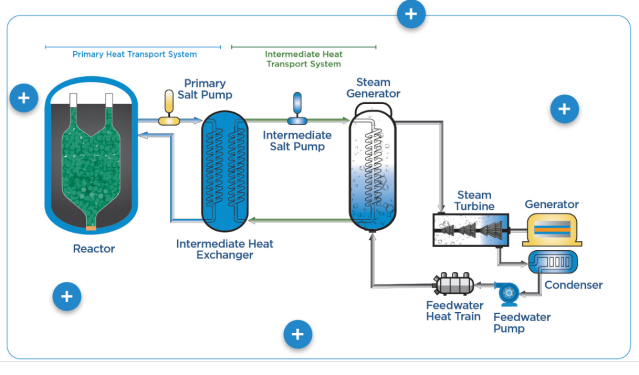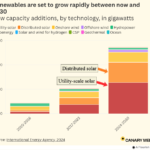(NucNet contributed to this report) Kairos Power and Google have signed a Master Plant Development Agreement, creating a path to deploy a U.S. fleet of multiple advanced nuclear power projects totaling 500 MW by 2035.
Under the agreement, Kairos Power will develop, construct, and operate a series of advanced reactor plants and sell energy, ancillary services, and environmental attributes to Google under Power Purchase Agreements (PPAs).
Kairos said the units for Google will include a single 50-MW reactor, with three subsequent power plants that would each have two 75-MW reactors.

With delivery times near a decade in the future, projecting costs from 2024 going forward is at best an exercise in scenario planning. Similarly, estimating what Google will pay for the power in 2035 is an open question.
The project site – or whether there could be reactors at multiple locations – have not been disclosed by either party. Google would have data centers somewhere in the region near the Kairos reactors, but it has not been determined whether they would receive power directly from the nuclear plants or from the grid.
The company did not disclose the financial terms of the deal. Google’s liability under the deal is to buy power from Kairos nuclear reactors. This means that Kairos will build, own, operate, and sell power from the reactors to Google.
Unlike Microsoft or Amazon, Google has not previously publicized its interest in nuclear energy nor publicly recruited to hire expertise from the industry. The firm has promoted its use of renewable energy sources (hydro, solar, wind).
Plants will be sited in relevant service territories to supply clean electricity to Google data centers, with the first deployment by 2030 to support Google’s 24/7 carbon-free energy and net zero goals. It is unclear whether Google will seek greenfield sites for new data centers and co-locate Kairos reactors at them or add Kairos reactors as power sources for existing data centers.
“This landmark announcement will accelerate the transition to clean energy as Google and Kairos Power look to add 500 MW of new 24/7 carbon-free power to U.S. electricity grids,” said Michael Terrell, Google Senior Director of Energy and Climate.
Google said by committing to a so-called order book framework with Kairos, instead of buying one reactor at a time, it is sending a demand signal to the market and making a long-term investment to speed development of SMRs.
Outline of the Multi-Plant Agreement
The innovative, multi-plant agreement will support technology development by extending Kairos Power’s iterative demonstration strategy through its first commercial deployments. Building on progress from the early iterations, each new plant will enable continued learning and optimization to support accelerated commercialization.
Along the way, milestone-based accountability baked into the agreement will establish confidence in Kairos Power’s ability to deliver throughout the long-term partnership.
“Our partnership with Google will enable Kairos Power to quickly advance down the learning curve as we drive toward cost and schedule certainty for our commercial product,” said Mike Laufer, Kairos Power CEO and co-founder.
“By coming alongside in the development phase, Google is more than just a customer. They are a partner who deeply understands our innovative approach and the potential it can deliver.”
“Having an agreement for multiple deployments is important to accelerate the commercialization of advanced nuclear energy by demonstrating the technical and market viability of a solution critical to decarbonizing power grids while delivering much-needed energy generation and capacity,” said Jeff Olson, Kairos Power Vice President, Business Development & Finance.
“This early commitment from Google provides a strong customer demand signal, which reinforces Kairos Power’s continued investment in our iterative development approach and commercial production scale-up.”
Background: Work Has Begun On Demonstration Unit
Kairos will have to navigate complex approvals through the Nuclear Regulatory Commission (NRC), but already has clearance to build a demonstration reactor in Tennessee, which could start operating in 2027.
The Hermes Low-Power Demonstration Reactor, which could be operational in 2027, is the first and only Generation IV* reactor to be approved for construction by the NRC and the first non-light-water reactor to be permitted in the US in over 50 years. Hermes is a non-power version of Kairos Power’s fluoride salt-cooled high temperature reactor, the KP-HFR.
Kairos has also begun construction on a new reactor-grade salt production facility at its manufacturing development campus in Albuquerque, New Mexico.
Mike Laufer, chief executive and co-founder at Kairos, said the demonstration project and the Albuquerque plant are helping the company avoid spiraling costs, a pitfall of the conventional nuclear industry.
Kairos Power: The Reactor Technology
Kairos Power’s technology uses a molten-salt cooling system, combined with a ceramic, pebble-type fuel, to efficiently transport heat to a steam turbine to generate power. This passively safe system allows the reactor to operate at low pressure, enabling a simpler more affordable nuclear reactor design.
Instead of water, which is used in traditional reactors, Kairos uses molten fluoride salt as a coolant.
The molten salts transfer heat away from the reactor core. The heat can then be used either to produce electricity or for industrial processes such as oil refining, desalination, and steel production.
These reactors have several inherent safety advantages. The first, and possibly the most important, is that the reactor is operated at low pressure because the coolants never approach boiling point. Even in an accident, there would be no force expelling materials from the reactor, and no high-pressure containment system would be required to prevent such a release.
The plant will use TRISO coated particle fuel. TRISO – or “tristructural-isotropic” – fuel particles contain a spherical kernel of enriched uranium oxycarbide surrounded by layers of carbon and silicon carbide, which contains fission products.
Other major data center users – Microsoft and Amazon – have recently turned to nuclear power to support the energy intensive needs of data centers supporting artificial intelligence.
Previous Coverage on this Blog
# # #





